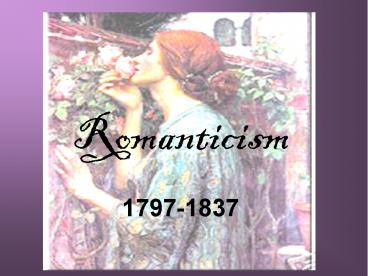Romanticism - PowerPoint PPT Presentation
Title:
Romanticism
Description:
Romanticism 1797-1837 A political movement condemning out-of marriage relationships? Novels and poems focused on love and sentimental relationships? – PowerPoint PPT presentation
Number of Views:286
Avg rating:3.0/5.0
Title: Romanticism
1
Romanticism
- 1797-1837
2
(No Transcript)
3
(No Transcript)
4
What differences do you see in the style of these
two paintings?
5
(No Transcript)
6
(No Transcript)
7
Which painting has more action in it? (Think
about it)
8
Now, which of these has more action?
9
Which one has more passion?
10
Is this music a good match for this painting of
Morgan le Fay?
11
Or is this music better suited to the
painting? Why?
12
What was the Romanticism movement in England?
13
- A political movement condemning out-of marriage
relationships?
14
- Novels and poems focused on love and sentimental
relationships?
15
- A bunch of liberal writers similar to the hippies
of the 1960s.
16
and the correct answer is. . .
- A bunch of liberal writers similar to the hippies
of the 1960s. (6 guys, actually)
17
The romantic movement was a revolt against
the prescribed rules of neoclassicism.
Lets see what that means
18
Neoclassicism was a movement that emphasized the
antique ideals of harmony and grandeur. Look at
the Honorable Mrs. Grahamthere she is in nature
leaning against a Roman column!
19
Classicism embraced the idea of human dominance
over nature and the belief that Reason would
ultimately reign supreme. Thus, in their attempt
to control nature, they sometimes, built fake
ruins that they would insert in a garden. It
looks natural. . . but its not. Its all about
looking natural, but really being in control.
20
Look at Mrs. Graham again. What is unnatural
about her portrait?
21
Romanticism preferred the vast wildernesses of an
indifferent and unpredictable nature with its
endless forests, towering clouds and deafening
waterfalls from icy giant peaks.
22
In Romanticism, artists and writers alike found
themes such as liberation, mysticism, exotic
orientalism, human insignificance and a darker
psychology more interesting than the dominant
impulse to bring order to the dark corners of the
world.
23
So, how do these beliefs affect the literature of
the time?
In Classicism But in Romanticism Reason
Artifice Imagination Naturalness Formal,
witty, public Simple, emotional, personal Man
controls nature Man mirrors nature Pragmatic/logi
cal Idealistic/sensibility Aristocrats Ordinary
people Society Individual Industrialized Exo
tic/mystical past Decorum control Spontaneity
and wildness
24
Do not confuse the term Romanticism with modern
terms dealing with love and romance. As a
literary movement, Romanticism reflects the
following basic themes
25
- Concern and sympathy for common people
- Interest in the world of imagination, especially
the supernatural - Rebellion against any form of tyrannical control
- Love of nature in all of its aspects
- Interest in past legends, especially the medieval
and primitive - Involvement with the lonely and melancholic,
especially in the contemplation of eventual death
and dissolution - A focus on individual feelings, not intellect
- An interest in childhood
26
William Wordsworth the Father of Romanticism
- In Lyrical Ballads, the book that started the
Romanticism movement, Wordsworth asked, What is
a poet? His answer began - He is a man speaking to men.
27
He went on to write Poetry is the spontaneous
overflow of powerful feelings. . . The principal
object is to choose incidents and situations
from common life, and to relate or describe them.
. . to throw over them a certain colouring of the
imagination, whereby ordinary things should be
presented in an unusual way.
28
Lyric
For Wordsworth, good poetry was the spontaneous
overflow of powerful feelings. And such poetry
should use the simple language of the everyday
person and be about commonplace subjects. But
the poem should also have a moment of
self-revelation. That kind of poem is called a
lyric.
29
What is a lyric poem?
- A lyric poem is a poem that
- Has musical properties but is intended to be
read, not sung - Is usually brief (but can be a page or two)
- Has some emotional intensity
- Represents thought and feeling in an
understandable way
30
Lets look at the poetry of the Romantics . .
.Get a textbook and turn to page 640































